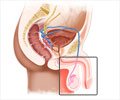Autism typically appears during the first two years of life and affects the brain's normal development. The new test uses 24 metabolites in the blood to detect autism.

- An algorithm that predicts autism uses 24 metabolites in the blood to detect the Autism Spectrum Disorder (ASD).
- Observing the symptoms as the child grows is the key for diagnosis but it is an obstacle to early diagnosis and treatment.
- Autism does not have a proper diagnostic test and so the predictive model using blood metabolites can help in early detection of ASD.
"Instead of looking at individual metabolites, we investigated patterns of several metabolites and found significant differences between metabolites of children with ASD and those that are neurotypical. These differences allow us to categorize whether an individual is on the Autism spectrum," said Juergen Hahn, lead author, systems biologist, professor, and head of the Rensselaer Department of Biomedical Engineering.
The different patterns in metabolites is found to be relevant to two connected cellular pathways and a series of interactions between molecules that control cell function that are related to ASD.
One is the methionine cycle which is linked to several cellular functions, including DNA methylation and epigenetics. The other one is the transulfuration pathway which results in the production of the antioxidant glutathione, decreasing oxidative stress.
What is Autism Spectrum Disorder?
Children with autism have difficulty in communication and social interaction. They often come across as those who remain engrossed with restricted and repetitive behavior patterns. No two people with autism will have exactly the same symptoms. Therefore, health care providers think of autism as a ‘spectrum’ disorder.
Predictive Algorithm Model
An application of Fisher Discriminant Analysis - a big data analysis technique was used to generate a predictive algorithm that analyses data.
Individual metabolites produced by the methionine cycle and the transulfuration pathways are associated with ASD but the correlation has been inconclusive.
"Because we did everything possible to make the model independent of the data, I am very optimistic we will be able to replicate our results with a different cohort," said Hahn, a member of the Rensselaer Center for Biotechnology and Interdisciplinary Studies (CBIS). "This is the first physiological diagnostic and it's highly accurate and specific."
"A lot of studies have looked at one biomarker, one metabolite, one gene, and have found some differences, but most of the time those differences weren't statistically significant or the results could not be reliably replicated," Hahn said.
"Our contribution is using big data techniques that are able to look at a suite of metabolites that have been correlated with ASD and make statistically a much stronger case."
"Professor Hahn's innovative work to improve the diagnosis for Autism as well as other ongoing efforts to advance diagnostics and develop new treatments for Alzheimer's and neurodegenerative diseases at CBIS show how new breakthroughs in health care are possible when we focus our work at the interface between traditional boundaries," said Deepak Vashishth, director of the CBIS.
"If these pathways are different, what happens if I can manipulate the pathway so that it works similarly to the neurotypical ones?" said Hahn. "What do I need to prod? Which molecules do I need to add or take away? Having a model that describes these pathways makes it a lot easier to adjust them."
Facts and Statistics on Autism
- Autism spectrum disorder occurs in 1 in 160 children worldwide.
- Prevalence in many low-and middle-countries is still unknown.
- The Centre for Disease Control and Prevention reports 1 in 68 children in the United States to have autism-related disorders. This has increased compared to a number of 1 in 88 kids in 2012.
- Autism is more often diagnosed in boys than girls.
- It is estimated that prevalence is increasing globally due to awareness, better diagnostic tools and criteria and better reporting.
If the child does not do most of the things mentioned in the list, the chances of autism could be high and requires immediate assessment.
- Babble or baby talk by 12 months
- Point out things by the end of first year.
- Utter a word by the middle of the second year.
- Speak two-word sentences by the end of two years
- Respond to their own name
- Make eye contact
- Interact socially
- Play with toys
- Laugh or smile
Reference:
- A blood test for autism - (https://www.eurekalert.org/pub_releases/2017-03/rpi-abt031617.php)
- Autism Spectrum Disorder - (https://www.nimh.nih.gov/health/topics/autism-spectrum-disorders-asd/index.shtml?utm_source=rss_readersutm_medium=rssutm_campaign=rss_full)
- What Is Autism? - (https://www.autismspeaks.org/what-autism)
Source-Medindia














